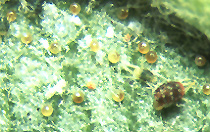
European Red Mite, Panonychus ulmi (Koch) and
Twospotted Spider Mite, Tetranychus urticae Koch
I. Introduction, Hosts, Description, Biology and
Monitoring for these pests are discussed in
the apple section.
II. Injury: Mites typically do not become abundant and injurious
to peach and nectarine until
mid-to-late summer. Feeding occurs on leaves and results in the removal
of chlorophyll which gives
the foliage a gray or bronzed appearance. This feeding, probably
because it occurs late in the season,
does not appear to have a detrimental impact on the quality and
quantity of fruit production in the
same year. High mite populations can result in premature leaf drop
which could increase tree
susceptibility to winter injury. Other long term or carryover effects
from one season to the
next have not been adequately investigated. Mites are often most
troublesome during the harvest
period by being a nuisance or irritant to pickers.
III. Monitoring: Follow mite densities during the season by
counting mites per leaf with a
hand lens or leaf-brushing machine. Take 10-40 leaves from the canopies
of 10 trees (use the
larger number in spring, when mites are harder to detect). Action
thresholds are only provisional
on peach and nectarine. However, recent research has shown that peach
is only about half as
sensitive to mite feeding as apple. Therefore, use an action threshold
of about 10 mites per
leaf early in the season, and 20 mites per leaf late in the season.
Thresholds may need to be
adjusted based on the sensitivity of pickers to mites.
See Univ. of California links to ERM on peach and nectarine.
Additional Reading:
- Mobley, K. N. and R. P. Marini. 1990. Gas
exchange characteristics of apple and peach leaves infested by European
red mite and twospotted spider mite. J. Am. Soc.Hortic. Sci. 115:
757-761.
This is taken primarily from a chapter by H. W.
Hogmire and D. F. Polk on peach indirect pests,
reprinted with permission from Mid-Atlantic Orchard Monitoring Guide,
published
by
NRAES, 152 Riley-Robb Hall, Ithaca, New York 14853-5701. (607)
255-7654.
Back to Virginia
Peach
page
Back to Virginia Fruit
Page